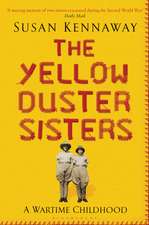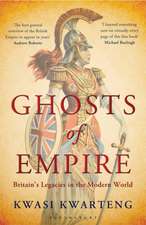The American Marshall Plan Film Campaign and the Europeans: A Captivated Audience?
Autor Professor Maria Fritscheen Limba Engleză Hardback – 7 feb 2018
| Toate formatele și edițiile | Preț | Express |
|---|---|---|
| Paperback (1) | 233.81 lei 6-8 săpt. | |
| Bloomsbury Publishing – 18 sep 2019 | 233.81 lei 6-8 săpt. | |
| Hardback (1) | 718.02 lei 6-8 săpt. | |
| Bloomsbury Publishing – 7 feb 2018 | 718.02 lei 6-8 săpt. |
Preț: 718.02 lei
Preț vechi: 1029.74 lei
-30% Nou
Puncte Express: 1077
Preț estimativ în valută:
137.39€ • 149.71$ • 115.77£
137.39€ • 149.71$ • 115.77£
Carte tipărită la comandă
Livrare economică 23 aprilie-07 mai
Preluare comenzi: 021 569.72.76
Specificații
ISBN-13: 9781350009332
ISBN-10: 1350009334
Pagini: 360
Ilustrații: 37 b/w sets of illustrations
Dimensiuni: 156 x 234 mm
Greutate: 0.67 kg
Editura: Bloomsbury Publishing
Colecția Bloomsbury Academic
Locul publicării:London, United Kingdom
ISBN-10: 1350009334
Pagini: 360
Ilustrații: 37 b/w sets of illustrations
Dimensiuni: 156 x 234 mm
Greutate: 0.67 kg
Editura: Bloomsbury Publishing
Colecția Bloomsbury Academic
Locul publicării:London, United Kingdom
Caracteristici
Analyses all 170 of the Marshall Plan films left in existence and also considers the political context of their production
Notă biografică
Maria Fritsche is Professor in the Department of Historical Studies at the Norwegian University of Science and Technology, Norway. She is the author of Homemade Men in Postwar Austrian Cinema: Nationhood, Genre and Masculinity (2013).
Cuprins
List of TablesList of ImagesIntroduction1. Visualizing the Marshall Plan2. By Europeans - For Europeans: Local Film Production3. The Cold War as Text and Context4. US Policy into Film: Productivity5. US Policy into Film: European Integration6. Filmmakers and Information Officers as Cultural Transmitters7. Marshall Plan Films and their Audiences8. Distribution and Exhibition9. ConclusionFilmographyBibliography and SourcesIndex
Recenzii
The American Marshall Film Campaign and the Europeans is a solid study that teaches us a lot about MP films and their role in shaping transatlantic affairs during the early Cold War. Readers interested in cinema, cultural policy, and international relations will greatly benefit from this volume.
Whereas other scholars have explored Marshall Plan films in different thematic and national contexts, Fritsche. [Is] the first to rise to the occasion of the film campaign's resolutely transnational framework.
Fritsche's study provides critical insight into the workings of a transatlantic and trans-European project. She also ably demonstrates how changing Cold War circumstances, such as the Korean War, altered the direction of film propaganda. While the ultimate efficacy of the propaganda campaign is difficult to judge, Fritsche's reconstruction of the politics, cinematic subject matter, and dissemination methods for the propaganda provides an important window into postwar international politics. Summing Up: Recommended. Upper-division undergraduates and above.
Based on the analysis of almost 170 films, multilingual bibliography and documents from the US National Archives and European film archives, Fritsche's research uncovers some interesting findings ... [Her] methodological combination of textual records with sharp visual analysis, articulating production, discourse, circulation and reception, is an example to be followed
Fritsche's final point that the ECA documentaries were part of a wider process of cultural transfer is surely correct ... this volume, although recounting events of the past, remains very relevant today.
Fritsche's book is a much-needed resource for teaching both advanced undergraduate and graduate-level media and history courses. It is a must-read book in methodology courses for discussing how film historiography is put into action to explore government-sponsored media infrastructures. Moreover, this book is a fantastic resource for learning how to conduct interdisciplinary research that brings together and builds upon the knowledge produced from the individual fields and disciplines.
This is as complete a history of Marshall Plan films as we are ever likely to get, or need. So, hats off to Maria Fritsche for this outstanding effort.
Whereas other scholars have explored Marshall Plan films in different thematic and national contexts, Fritsche. [Is] the first to rise to the occasion of the film campaign's resolutely transnational framework.
Fritsche's study provides critical insight into the workings of a transatlantic and trans-European project. She also ably demonstrates how changing Cold War circumstances, such as the Korean War, altered the direction of film propaganda. While the ultimate efficacy of the propaganda campaign is difficult to judge, Fritsche's reconstruction of the politics, cinematic subject matter, and dissemination methods for the propaganda provides an important window into postwar international politics. Summing Up: Recommended. Upper-division undergraduates and above.
Based on the analysis of almost 170 films, multilingual bibliography and documents from the US National Archives and European film archives, Fritsche's research uncovers some interesting findings ... [Her] methodological combination of textual records with sharp visual analysis, articulating production, discourse, circulation and reception, is an example to be followed
Fritsche's final point that the ECA documentaries were part of a wider process of cultural transfer is surely correct ... this volume, although recounting events of the past, remains very relevant today.
Fritsche's book is a much-needed resource for teaching both advanced undergraduate and graduate-level media and history courses. It is a must-read book in methodology courses for discussing how film historiography is put into action to explore government-sponsored media infrastructures. Moreover, this book is a fantastic resource for learning how to conduct interdisciplinary research that brings together and builds upon the knowledge produced from the individual fields and disciplines.
This is as complete a history of Marshall Plan films as we are ever likely to get, or need. So, hats off to Maria Fritsche for this outstanding effort.






